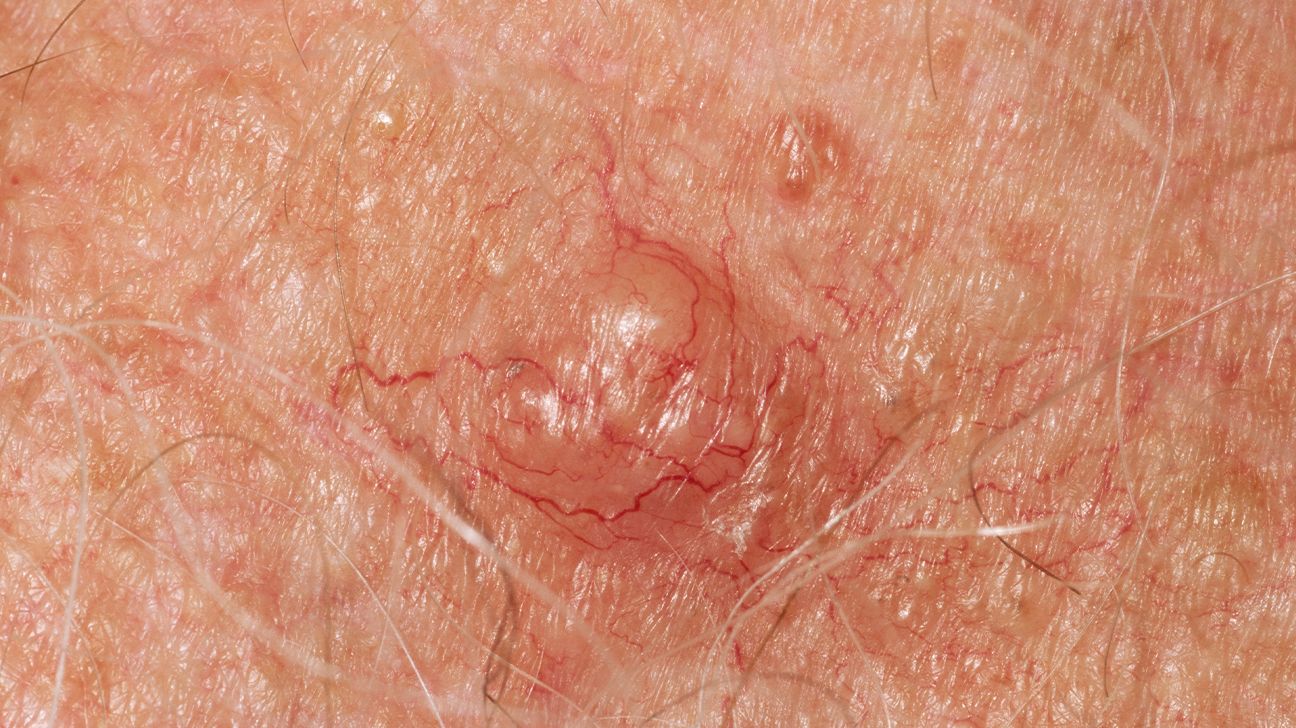Subtypes of basal cell carcinoma, the most common type of skin cancer, may differ in appearance, aggressiveness, treatment options, and who’s likely to develop them.
Basal cell carcinoma (BCC) is the most common type of skin cancer. It begins in the basal cells, located in the deepest layer of the epidermis.
There are several types of BCC, each of which may differ in appearance and severity. BCC often looks like bumps, growths, sores, scars, or red patches.
BCC is highly curable when detected early and rarely spreads to distant body parts. However, in rare cases, if it spreads (metastasizes) and is left untreated, it can become life threatening.

Nodular BCC represents around
It appears as a pearly, translucent bump, often on sun-exposed areas like the face, chest, and back. It may have visible blood vessels that may ulcerate or bleed in larger lesions.
This type of carcinoma often grows slowly and can spread to other body parts if untreated. Possible treatment options may include:
- surgical excision
- Mohs surgery
- topical therapies
- radiation (in specific cases)
Superficial BCC is a less aggressive form of skin cancer characterized by well-defined flat, waxy, or scaly spots or reddish patches resembling other skin conditions like eczema or psoriasis. It’s
Superficial BCC often grows slowly and is typically less aggressive, making it less likely than other types to invade surrounding tissues.
Due to its superficial nature, treatment options may include:
- topical creams like imiquimod (Aldara, Zyclara) or 5-fluorouracil (Efudex)
- cryotherapy
- photodynamic therapy
- surgical excision
Morpheaform BCC (aka sclerosing BCC) is an invasive subtype that accounts for about
This subtype often occurs on the face and neck, and its treatment typically involves surgical procedures like Mohs surgery to ensure complete removal. This is important due to its invasiveness and recurrence rate after treatment.
Pigmented BCC is
This form of skin cancer can sometimes be more challenging to diagnose as it may resemble other pigmented lesions. Treatment options may include surgical excision or Mohs surgery.
Scientists can also classify BCC according to the way the cancerous cells look under a microscope. These are known as histological subtypes and may present with different appearances, locations, and severity. These subtypes may include:
- Micronodular BCC: This type is similar to nodular BCC but with smaller nodules. It’s often found on the back as light yellowish lesions that do not ulcerate. Treatment may include Mohs surgery due to its precision in removal.
- Infiltrating BCC: Often occurring in the face and upper trunk, this type may appear as a white plaque. It’s more aggressive than other forms of BCC. Treatment typically involves surgical removal or radiation therapy if surgery isn’t suitable.
- Infundibulocystic BCC: This type typically presents as small, multiple cyst-like lesions that
often appear on the face. Since it progresses slowly, treatment options may include excision or Mohs surgery to less aggressive treatments like topical therapies. - Basosquamous BCC: Also known as metatypical BCC, this is the
most aggressive subtype of BCC, often showing features of both basal and squamous cell carcinomas (SCC). It’s more likely to spread to other body parts and recur. - Fibroepithelioma of Pinkus: This slow-growing tumor is more common in females with light skin. It typically appears as a small, pink, or skin-colored growth on the lower back but may occur anywhere on the skin. Surgical excision is the primary treatment.
- BCC with sarcomatoid differentiation: This is an aggressive form of skin cancer in which cancerous basal cells are part of a sarcoma, a cancer that affects soft tissue. Treatment may involve surgical excision and additional therapies like radiation or targeted therapy.
- BCC with adnexal differentiation: This type is
often found in the skin around the eyes and may have features similar to the usual structures around hair follicles and sweat glands, complicating diagnosis. - BCC with sebaceous differentiation: This type
may appear as nodular lesions characterized by mature sebaceous cells, sebaceous ducts, or sebum within the tumor, resembling other sebaceous tumors.
What are the aggressive forms of basal cell carcinoma?
The aggressive forms of BCC
- infiltrative
- morpheaform
- basosquamous
- micronodular
These types are more likely to invade surrounding tissues and have a higher risk of recurrence than other forms of basal cell carcinoma.
Doctors determine the different types of BCC based on a combination of visual examination and biopsy. They’ll examine the lesion’s size, shape, and color, including its borders and surrounding skin.
A skin biopsy may help healthcare professionals confirm the diagnosis and identify the specific BCC type. This procedure involves removing a small sample of the affected skin and examining it under a microscope.
Based on the results, they can classify the type of BCC and develop an appropriate treatment plan.
BCC types include nodular, superficial, morpheaform, and pigmented, each with different characteristics.
Early detection may increase the chance of curing the condition, and treatment options may vary from surgical excision to topical therapies.
